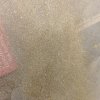You are using an out of date browser. It may not display this or other websites correctly.
You should upgrade or use an alternative browser.
You should upgrade or use an alternative browser.
7mm Pencarrow - Cornish BR(S)
- Thread starter Pencarrow
- Start date
Pencarrow
Western Thunderer
Really nice work on the Buffer stop Chris. Very Inspirational pal
Mick
Cheers Mick, just got the other 98% of the layout to finish!
Painting stonework
Pencarrow
Western Thunderer
Question from Dan on another thread about how I did this stonework:

OK, the answer is that it's all a bit trial and error and that I keep going until I get the finish looking about right.
So to start with you have your model wall. I invariably use plasticard and the one above is Wills Coarse Stone which has been abused with files, sandpaper, filler and other sharp objects.
I then give it a coat of Halfords rattle can grey primer. Now, I don't know if this makes a difference but, I generally don't wait for the primer to full dry before overspraying with the base colour coat. For this I have 4 cans (picked up on offer from Hobbycraft about October time):

They are shades of tan (sand), cream (elm), brown (mushroom) and grey (gravel). They were an impulse buy but I like the textured matt finish you can get if breaking every spray rule in the book.
First of all I spray at a distance so that the paint is semi dry when it hits the wall. Then I only give partial patchy coverage to each coat and rotate through using each colour quickly in turn, doing about 3 rotations in total (12 coats in all).
I didn't get a photo of this but here's one of the paper I put down to catch the overspray:
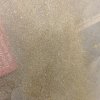
The spraying from a distance means you get a rough textured finish and the use of multiple patchy colours means you get a random colouration. (these are very quick passes with the can, not dumping much paint).
Next I mixed up a thin wash of cream paint and let that run through all the mortar layers. Once that had dried off I turned to using these:

Artists gouache. It's a weird paint as it dries but never really sets and can be reworked by just getting it damp again. I put bits of each colour on a palette and mix up stony colours with the smallest amount of water. Then apply these various colours, almost drybrushed, on to random stones. The aim is to add a bit more colour variation, hints of colour rather than a complete repaint.
Once happy I give it a coat of spray matt varnish so seal the gouache. In this case I gave if another thin wash of the mortar colour. As a final task I treated a few stones to a lick of weathering powder:
I hope that helps. It's not a fixed recipe and I make it up as I go along but using the limited range of colours does mean the results have a family appearance.
OK, the answer is that it's all a bit trial and error and that I keep going until I get the finish looking about right.
So to start with you have your model wall. I invariably use plasticard and the one above is Wills Coarse Stone which has been abused with files, sandpaper, filler and other sharp objects.
I then give it a coat of Halfords rattle can grey primer. Now, I don't know if this makes a difference but, I generally don't wait for the primer to full dry before overspraying with the base colour coat. For this I have 4 cans (picked up on offer from Hobbycraft about October time):

They are shades of tan (sand), cream (elm), brown (mushroom) and grey (gravel). They were an impulse buy but I like the textured matt finish you can get if breaking every spray rule in the book.
First of all I spray at a distance so that the paint is semi dry when it hits the wall. Then I only give partial patchy coverage to each coat and rotate through using each colour quickly in turn, doing about 3 rotations in total (12 coats in all).
I didn't get a photo of this but here's one of the paper I put down to catch the overspray:

The spraying from a distance means you get a rough textured finish and the use of multiple patchy colours means you get a random colouration. (these are very quick passes with the can, not dumping much paint).
Next I mixed up a thin wash of cream paint and let that run through all the mortar layers. Once that had dried off I turned to using these:

Artists gouache. It's a weird paint as it dries but never really sets and can be reworked by just getting it damp again. I put bits of each colour on a palette and mix up stony colours with the smallest amount of water. Then apply these various colours, almost drybrushed, on to random stones. The aim is to add a bit more colour variation, hints of colour rather than a complete repaint.
Once happy I give it a coat of spray matt varnish so seal the gouache. In this case I gave if another thin wash of the mortar colour. As a final task I treated a few stones to a lick of weathering powder:

I hope that helps. It's not a fixed recipe and I make it up as I go along but using the limited range of colours does mean the results have a family appearance.
Dan Randall
Western Thunderer
Thanks Chris, that's great. 
Regards
Dan

Regards
Dan
Pencarrow
Western Thunderer
Thanks Chris, that's great.
Regards
Dan
Not sure how much help it is but you did ask! I generally just use what's to hand and experiment until it looks about right. The results from the four colour spray cans are encouraging though and give me a few ideas...
Dan Randall
Western Thunderer
Hi Chris
Your technique will certainly be of use to me if/when I have an open area of concrete (or stone), to portray.
Unfortunately, the structures I'm working on (currently a bit "Top Secret", as I'm hoping to write a magazine article about them), have some deep recesses where your spray technique would not work, at least, not without a large build up of unwanted paint on the surrounding surfaces. I don't think masking them would help either, as I'd be worried about getting ridges and/or different results between the surfaces.
Funnily enough, I've just finished slapping another coat of Tamiya "Deck Tan" on them, as the basis of my concrete colour. I need to apply a mix of additional concrete/earthy colours in due course (with added talc for matting and texture), perhaps followed by some ground-up artist's pastels.
Regards
Dan
Your technique will certainly be of use to me if/when I have an open area of concrete (or stone), to portray.
Unfortunately, the structures I'm working on (currently a bit "Top Secret", as I'm hoping to write a magazine article about them), have some deep recesses where your spray technique would not work, at least, not without a large build up of unwanted paint on the surrounding surfaces. I don't think masking them would help either, as I'd be worried about getting ridges and/or different results between the surfaces.
Funnily enough, I've just finished slapping another coat of Tamiya "Deck Tan" on them, as the basis of my concrete colour. I need to apply a mix of additional concrete/earthy colours in due course (with added talc for matting and texture), perhaps followed by some ground-up artist's pastels.
Regards
Dan
Cattle dock
Pencarrow
Western Thunderer
Looks like I've not yet reported the placement of some more platform edging and the constructikn of the dock.
For the top of the dock I'm working off the small corner of a photo...

Blue brick edgings, stone corners, gully gratings and the tip dished to the centre.

I've gone for using Wills coarse stone sheets again. The surface sanded down to reduced the moulded texture, filler applied over the joints and new blocks carved.


Corners formed from the middle of a sheet, overlapped, filed down and blocks reinstated.
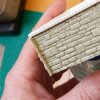
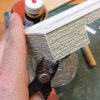
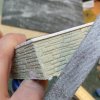

More to follow...
For the top of the dock I'm working off the small corner of a photo...

Blue brick edgings, stone corners, gully gratings and the tip dished to the centre.
I've gone for using Wills coarse stone sheets again. The surface sanded down to reduced the moulded texture, filler applied over the joints and new blocks carved.


Corners formed from the middle of a sheet, overlapped, filed down and blocks reinstated.




More to follow...
Buffer stops - many types
Pencarrow
Western Thunderer
In my 'inspired by'version of Bodmin North I've removed one of the four tracks terminating near the grain store. Going from left to right in the photo below, I've got: track 1 the platform and loco release; track 2 siding; and track 4 the loading dock road.

At the end of my loading dock road I'm using a Ragstone Models SR bufferstop. In the siding I'm replicating what I can see attached to the wall in plasticard. At the end of the loco release I'm knocking up the half bufferstop out of scrap rail and plastic based on the Ragstone kit dimensions.
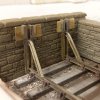
Plates and bolts still to add...
At the end of my loading dock road I'm using a Ragstone Models SR bufferstop. In the siding I'm replicating what I can see attached to the wall in plasticard. At the end of the loco release I'm knocking up the half bufferstop out of scrap rail and plastic based on the Ragstone kit dimensions.


Plates and bolts still to add...
Pencarrow
Western Thunderer
The brickwork edging and dished top on the loading dock comes from a sheet of SEF stretcher bond plasticard. Two layers of 30thou were stuck under the edging to make up a brick depth. Mortar lines were then cut/sawn into the edge. I've found you have to do this otherwise painting fills the gap.


Gully pots were made up from plasticard and microstrip. The grating bars are 15thou.
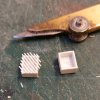

And I think reasonably looks the part when set in place...

Will look good with grass growing up out if them!


Gully pots were made up from plasticard and microstrip. The grating bars are 15thou.


And I think reasonably looks the part when set in place...

Will look good with grass growing up out if them!
jonte
Western Thunderer
Most impressive, Chris. The shading and weathering is really convincing.
Thanks for sharing your tips, especially the joining/ reworking of the ubiquitous but excellent Wills sheets. I remember an article in a recent MRJ on how to seamlessly join these sheets; while impressive, this looks far less complicated but equally convincing.
Jonte
Thanks for sharing your tips, especially the joining/ reworking of the ubiquitous but excellent Wills sheets. I remember an article in a recent MRJ on how to seamlessly join these sheets; while impressive, this looks far less complicated but equally convincing.
Jonte
Pencarrow
Western Thunderer
Most impressive, Chris. The shading and weathering is really convincing.
Thanks for sharing your tips, especially the joining/ reworking of the ubiquitous but excellent Wills sheets. I remember an article in a recent MRJ on how to seamlessly join these sheets; while impressive, this looks far less complicated but equally convincing.
Jonte
Thanks Jonte, glad you have found some of the above useful.
I get most of the MRJs but don't recall an article on the Wills sheets, must be one I didn't get. Could you tell me which it was in please?
Will be interesting to see how others tackle the same task. I have found though that the can be a tendency in MRJ to find over complicated ways of doing things.
I suspect my methods of abusing tools, overuse of solvent and dabbing filler everywhere would be frowned upon by some. ;-p
jonte
Western Thunderer
Thanks Jonte, glad you have found some of the above useful.
I get most of the MRJs but don't recall an article on the Wills sheets, must be one I didn't get. Could you tell me which it was in please?
Will be interesting to see how others tackle the same task. I have found though that the can be a tendency in MRJ to find over complicated ways of doing things.
I suspect my methods of abusing tools, overuse of solvent and dabbing filler everywhere would be frowned upon by some. ;-p
Perhaps one or two might frown upon your method, Chris, but certainly not the outcome. It works marvellously and surely that’s all that matters?
I’ll have a trawl through my mags a little later and let you know which issue to which I refer.
From memory, the repeat pattern ends up forming a jig-saw shape before being joined.
Incidentally, if it transpires that you don’t have that particular issue, let me know once I’ve posted the outcome and I’ll PM you if that’s ok.
Jonte
adrian
Flying Squad
It was issue 247I get most of the MRJs but don't recall an article on the Wills sheets, must be one I didn't get. Could you tell me which it was in please?
Issue 247
Karl Crowther and Hebble Vale Goods and very impressive
EM Gauge Layouts, Models & Projects
when it produces results as good this does it really matter?I suspect my methods of abusing tools, overuse of solvent and dabbing filler everywhere would be frowned upon by some. ;-p
jonte
Western Thunderer
Thanks folks. Issue 247, cover looks familiar...will have to have a look see.
As Adrian says, issue no. 247 pertains, p. 131.
If you don’t have it, let me know.
Jonte
Pencarrow
Western Thunderer
It doesn't matter what method you use as long as the end result looks good
I used to cut/glue and file corner stones as you did, but I found an easier and quicker method is to just V file the back of the sheet, add some solvent to soften and just bend to 45 deg.
Phil
I've done that before as well Phil. It does mean you have to get the v notch in the right place, which can be a bit tricky. More than one way to skin a cat though!
Pencarrow
Western Thunderer
Managed to find the MRJ. Very similar to what I've done. Karl also uses filler, all be it more precisely than me! He also takes out the stones with the diagonal corners and sands the sheets down.
He has kept all the sheets oriented the same way though, which does mean the repeat pattern is more obvious (probably only to someone else who has spent a long time working on these sheets) than rotating the sheets (which needs more filler at the join).
Horses for courses. Interesting though.
He has kept all the sheets oriented the same way though, which does mean the repeat pattern is more obvious (probably only to someone else who has spent a long time working on these sheets) than rotating the sheets (which needs more filler at the join).
Horses for courses. Interesting though.

